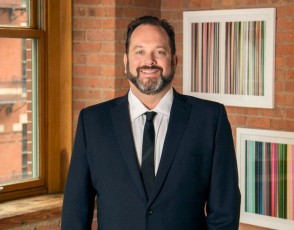For Robin Schneiderman, winning new assignments is all about the money. But not the money going into his pocket.
Schneiderman, of Halstead Property Development Marketing, is focusing on connecting developers with what they need most in a tighter financing environment: capital. Rather than spending his time on devising splashy marketing campaigns, he’s courting hedge-funders, private equity bosses and mortgage brokers.
Helping developers find investors and lenders for their projects could see them return the love by granting him an exclusive contract to sell the units, he said.
“I sometimes go as far as helping clients connect with people who can help them raise LP capital and have done that successfully,” Schneiderman said, noting that while he’s not brokering loans himself, he now knows plenty of people who can.
“If you can bring in a capital partner, especially when the market has tightened as far as equity or debt-side construction loans, that goes a long way,” he added.
Schneiderman’s tactics speak to a broader shift in how firms are approaching the war for new development projects, which are the brokerage world’s most coveted prizes. A single major project can mean hundreds of millions of dollars of business for a firm, and the market is large: In the year ending in February, new development marketing firms secured a collective $25 billion in Manhattan exclusives, according to TRD’s most recent count.
The closest parallel would be the “Mad Men”-era advertising business, when a huge account could set an agency up for years. But today’s brokerages aren’t dealing with executives from Pan Am or Philip Morris who might have been wooed by a killer Don Draper slogan. The masters of their fate are instead hard-nosed builders such as JDS Development Group, HFZ Capital Group and Extell Development Company that are looking for someone who buyers and lenders would be comfortable with.
“Just as important as the firm we select to work with on a project are the specific individuals that make up the sales team from that firm,” said JDS Chief Executive Officer Michael Stern, who has tapped Douglas Elliman, Corcoran Sunshine and CORE on various projects.
The pitch process has become less about showmanship and head-to-head competition, sources said. It’s now more about selling the long-term personal expertise of the broker, leveraging any personal relationships the brokerage’s executives might have, courting lenders and equity partners and doing everything possible to avoid the pitch room altogether.
The biggest firms tout their track records and the depth of resources they can bring to the table. Smaller firms try to use their larger rivals’ scale against them, selling developers on the notion that the big firms can’t provide the same level of devotion to projects.
And as some developers nervous about the luxury market’s prospects are scrutinizing every decision, sources said the jostling between brokerages has become increasingly fierce.
It’s “friendly competitive warfare,” said Kelly Kennedy Mack, president of Corcoran Sunshine, the city’s top new development marketing firm. Mack said she’s occasionally spotted rivals vying for the same projects in waiting rooms of developers’ offices.
“You think [the developers would] give you more room,” she joked.
The chokehold
Over the last few years, two firms — Corcoran Sunshine and Elliman — have largely dominated the market, handling the bulk of new projects when measured by total sellout. Each of them has exclusives on more properties than the rest of the market combined, followed by Compass and Stribling & Associates.
Being the biggest kid in the playground ensures you get noticed. For Mack, whose firm leads the market by almost 100 percent, with exclusives on $11.37 billion in property as of March, getting invited to compete is a given.

Kelly Kennedy Mack
“Pitches still happen, but they’re not as common for us because of the long-term nature of our client base,” said Mack, who works with the likes of Extell and Silverstein Properties. “More often than not, we have a preexisting relationship. Once in a while, we get someone who wants to come in and talk about a piece of property.”
Elliman, too, is generally always in the conversation. But what gives the firm an extra boost is the Lorber effect.
Howard Lorber, who chairs the firm, is also an active equity investor in new development projects through New Valley, his real estate investment company. New Valley is a partner on projects such as 111 Murray Street and the Park Lane with Witkoff, and 125 Greenwich Street with Bizzi & Partners and Michael Shvo. The chance to tap into Lorber’s capital is a big part of Elliman’s appeal to developers, sources said.
One developer told The Real Deal on the condition of anonymity that Lorber attended the pitch for his project and subsequent strategy meetings, advising on floor plans and finishes. That became a major reason why Elliman got the assignment, the developer said.
“When Howard is throwing equity around, I start to think to myself: ‘How can I compete with a guy like that when I don’t have millions of dollars to put into these things?’” said one new development expert, who also asked not to be named.
Town Residential, which was owned in part by Thor Equities’ Joseph Sitt until earlier this year, benefited from Sitt’s investment plays in a similar manner. Thor is a minority partner in 212 Fifth Avenue, a condominium conversion that the firm is co-developing with Madison Equities and Building and Land Technology. In February, Town got the nod to market the project, which has an estimated sellout of $523 million and includes a $68.5 million penthouse.
[vision_pullquote style=”3″ align=”right”] “When Howard is throwing equity around, I start to think to myself: ‘How can I compete with a guy like that when I don’t have millions of dollars to put into these things?’” [/vision_pullquote]But in July, Town’s founder and CEO Andrew Heiberger bought Sitt out of his stake. Asked last month whether losing the Sitt affiliation would hurt Town’s ability to score new business, Heiberger instead emphasized the pros, saying he would now be able to represent developers who compete with Thor.
“We’re purely independent,” he said. “I can’t imagine that developers always want their competition marketing their properties.”
At pitch time, firms highlight conflicts like these that their rivals might face, sources said, as well as others that might arise when a firm is handling several projects at once. Elliman, in particular, takes stick from rivals because the brokers it puts on new development projects often represent resales as well. There’s nothing to stop its brokers from taking clients from the new projects to their resale listings, where commissions are higher, competitors argue.
Representatives for Elliman declined to comment for this story.
In one instance, Ben Shaoul’s Magnum Real Estate Group replaced Elliman with Corcoran at 100 Barclay Street, prompting speculation that the on-site sales staff’s resale business didn’t allow for enough attention to the project. Elliman’s Vickey Barron, who headed sales at the building, is known for her knowledge of the building’s architect, Ralph Walker, from working on other Walker conversions at 212 West 18th Street and Stella Tower in Hell’s Kitchen. But her thriving resale business meant the property was just one of many she was hawking. Shaoul has declined to disclose sales figures at the project.
“This is what we do all day every day,” Mack said. “We do not participate on resale, and we have no other distractions.” Adrienne Albert, CEO of the Marketing Directors, echoed Mack’s sentiments.

A rendering of 45 East 22nd Street (credit: Williams New York)
“On-site sales and leasing is all we do,” said Albert, whose firm handles such projects as Time Equities’ 50 West Street in Lower Manhattan. “We don’t do resales. A person who works for us isn’t going to take the client’s prospects to any other listing. Because we are a boutique operation, we don’t take on that many jobs, and everybody gets first-level service.”
In some cases, however, how prolific a broker is may work in his or her favor.
In September, after a period of lackluster sales, Bruce Eichner’s Continuum Company replaced Corcoran with Elliman at 45 East 22nd Street. It was a bet that, despite his resale commitments, “Million Dollar Listing New York” star Fredrik Eklund would help raise the building’s profile in a crowded marketplace.
No race to the bottom
Prospective marketing teams occasionally sit down one on one with the developer, but increasingly, representatives for the lenders and the equity backers are also present. On the brokerage side, new development chiefs such as Elliman’s Susan de França and Halstead’s Stephen Kliegerman are typically accompanied by one or two of their agents who are experts on the neighborhood or who might be a familiar face to a developer. And even though Mack heads Corcoran Sunshine, Corcoran Group CEO Pam Liebman sometimes comes along on pitches.
[vision_pullquote style=”3″ align=”right”] “On-site sales and leasing is all we do. We don’t do resales.”
-Adrienne Albert [/vision_pullquote]The typical pitch meeting goes like this: Brokers and developers hash out the target buyers, the prospective unit mix, suggested pricing, expectations of velocity and issues of architecture and design. Firms try to stand out with innovative strategies and edgy marketing ideas. But unlike their counterparts in other industries, price is almost never a decisive factor.
Developers told TRD they never choose a firm based on commission structures. In the context of a billion-dollar condominium sellout, a percentage point here or there means little. What matters most, they said, is a team that can move product.
Mack said it’s rare that price even comes up in an initial pitch meeting. While Corcoran Sunshine may be a few percentage points more expensive than its rivals, if it can sell apartments at higher prices, that premium becomes irrelevant.
“The actual commission terms don’t come up until the end,” she said. “There have only been two cases in my 15 years where they chose us and we would not actually meet their fee demands and passed on the project.” Project sponsors agreed: “We didn’t talk about money at all, period,” said one investor of his pitch process. “We worked that out after the fact. When you’re selling hundreds of millions in real estate, the goal is just getting the best execution, not saving 25 basis points.”
Deciding how much to spend on a pitch is something firms constantly wrestle with. It’s a delicate balance: Spend too little and look like an amateur, spend too much and risk having nothing to show for it. The amount a company spends on its pitch varies from firm to firm — some brokerages will take a spartan approach and focus on the numbers, while others dial up the flash.
Heiberger said he’s spent in excess of $25,000 putting together presentations that included video marketing materials and commissioned architectural renderings, for which he footed the bill. He told TRD of one such presentation he prepared for Macklowe Properties’ One Wall Street, only to get beaten by CORE.
“You invest a lot of upfront money putting together very elaborate proposals, and you don’t get paid for it,” he said.
Brokerages could find themselves in a similar situation when projects are scrapped, as happened with Elliman on the condo conversion of the upper floors of the Sony Building, a project that had a projected sellout of $1.8 billion.
“I think the development marketing companies are pretty good at reading tea leaves with their clients and don’t count this as earned money,” said Jonathan Miller, president of appraisal firm Miller Samuel. “They know they’re taking on risk and incurring costs that aren’t necessarily going to be reimbursed, with the assumption that the project is going to move forward. They have to understand that to play in this sandbox.”
One consequence of the last recession is that the quiet money backing projects is becoming a lot more vocal.

Andrew Heiberger
New York real estate families and private developers once called all the shots when selling out their buildings. But now, lenders and silent equity partners are taking a much more active role in determining the sellout strategy. Brokers who keep them in mind could benefit.
“Financial backers are in the pitch meetings,” Heiberger said. “That’s a newer thing. Twenty years ago it used to just be you and the developer, and now that’s evolved.”
In the case of Projects Such As 432 Park Avenue, for instance, brokerage executives are as likely to sit down with private equity firm CIM as they are with the project’s public face, Harry Macklowe. And sometimes, the sponsor may not even have the final say on who gets hired.
“Dozens of times we were told we would get the project by the lead developers, only to learn later when it went through the ranks, another firm had gotten it through another contact — someone who brought more money or some other big investor,” Heiberger said.

